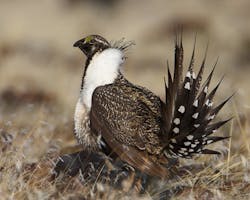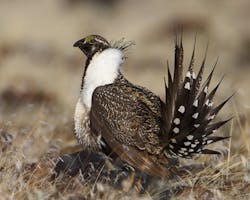Zinke signs order to improve greater sage grouse preservation efforts
US Interior Sec. Ryan K. Zinke signed an order late on June 7 that was aimed at improving greater sage grouse habitat preservation efforts across 11 western states and strengthening cooperation between the federal government and state and local governments, oil and gas producers, ranchers, outdoor recreation groups, and other stakeholders.
Secretarial Order 3353 also established an internal review team that will evaluate both federal greater sage grouse plans and state plans and programs to assure that they are complementary. The team also will consider local economic growth and job creation as it evaluates possible plan modifications.
“While the federal government has a responsibility under the Endangered Species Act to responsibly manage wildlife, destroying local communities and levying onerous regulations on the public lands that they rely on is no way to be a good neighbor,” Zinke said.
In Denver, Western Energy Alliance Pres. Kathleen Sgamma welcomed the news. “The announcement is just the start of a process to review the plans, albeit one with a better eye toward the state plans that were largely ignored by the Obama Administration,” she told OGJ via e-mail.
“It’s a positive first step, but just a procedural one that doesn’t change the fact that the 2015 federal plans, which don’t effectively protect the sage grouse but do kill jobs, are still in effect,” Sgamma said. “An earnest effort to redo the federal plans is welcome, but we’ll have to wait and see what comes out of the review.”
Zinke’s predecessor, Sally Jewell, announced in September 2015 that the US Fish and Wildlife Service would not list the bird as endangered or threatened under the federal Endangered Species Act following unprecedented cooperation involving state fish and game departments, oil and gas producers, county and local governments, and other stakeholders (OGJ Online, Sept. 22, 2015).
Such ESA protection potentially could stifle economic development across large areas of the American West where more than half of sage grouse habitat is on public lands managed by the US Bureau of Land Management and the US Forest Service, DOI said in its June 7 announcement of Zinke’s action.
WEA and the North Dakota Petroleum Council jointly sued the US Bureau of Land Management and US Forest Service in federal court in May 2016, charging that the agencies developed amended land use plans for the greater sage grouse that imposed restrictions on new oil and gas leases and on development of existing leases (OGJ Online, May 13, 2016).
Zinke asked the internal review team of experts from BLM, FWS, and the US Geological Survey to focus on addressing invasive grasses and wildland fire, the principal threats to rangeland health and greater sage grouse habitat. The team will also consider creative approaches and ideas, including a captive breeding program, setting population targets state-by-state, and opportunities to improve state involvement, DOI said.
Contact Nick Snow at [email protected].
About the Author

Nick Snow
NICK SNOW covered oil and gas in Washington for more than 30 years. He worked in several capacities for The Oil Daily and was founding editor of Petroleum Finance Week before joining OGJ as its Washington correspondent in September 2005 and becoming its full-time Washington editor in October 2007. He retired from OGJ in January 2020.

